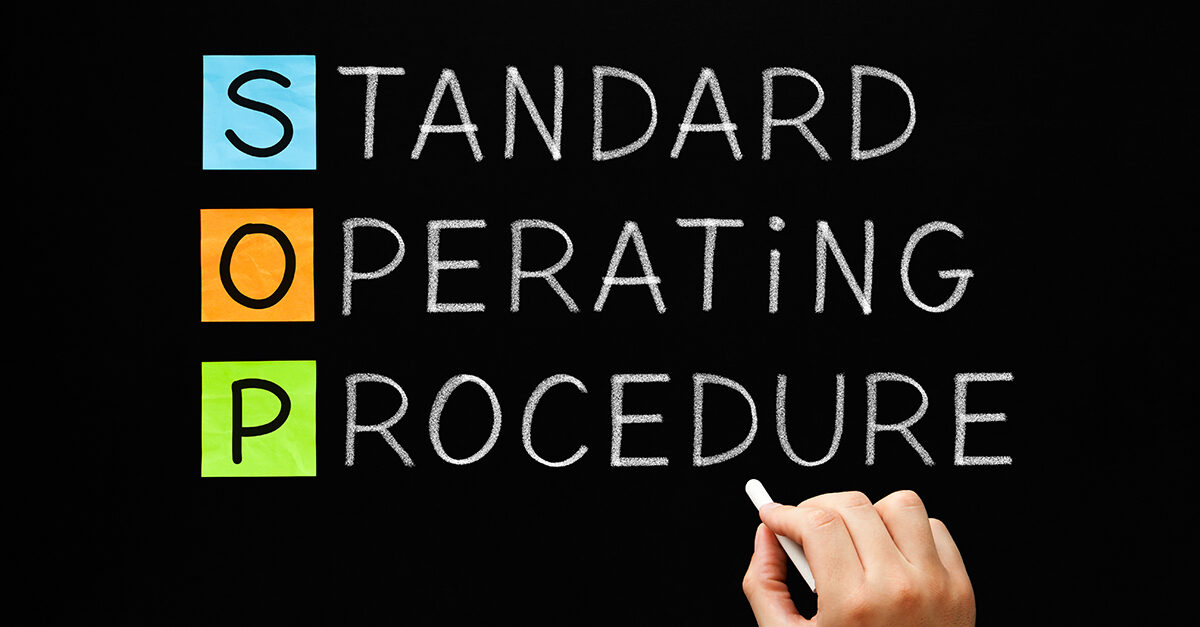Cleaning organizations play a critical role in keeping building occupants safe and healthy. A Berkeley National Laboratory survey found that in North America and Europe people spend over 90% of their time indoors. This means the effectiveness of the cleaning programs in the buildings they occupy can have a real impact on their health. Poor cleaning, for example, can contribute to poor health, but effective cleaning can potentially save lives. Cleaning effectiveness can be directly tied to an organization’s standard operating procedure (SOP). It is important, now more than ever, to ensure you have an SOP aligned with your company’s objectives—and those of your stakeholders—to create safe and healthy building environments. While some organizations have individual components of an SOP, many lack a fully designed and implemented procedure. Here are some guidelines to help you create and maintain a successful SOP for your cleaning organization.
What are SOPs?
Simply put, SOPs are brief, easy-to-understand-and-use documents that show action points and workflows. You can use SOPs to create process flowcharts for performing defined tasks. A well-thought-out SOP for a cleaning organization outlines steps (so you don’t have to repeat them) for routine actions like:
- Onboarding and training new employees
- Performing cleaning tasks
- Managing employees (both managers and workers)
- Fulfilling human resource practices
- Workloading cleaning tasks
- Standardizing tool use
- Encouraging employee recognition and engagement.
Three pillars of an SOP
The most successful organizations use an SOP for standardizing operations to achieve stability and growth. There is no one-size-fits-all process for writing an SOP, but one key point is to not overcomplicate the process. Here are three major pillars to help build your SOP:
Create a blueprint of your company’s most repetitive tasks—The blueprint should include duties performed on a repeated basis such as the actions listed above and other less-frequent tasks. Now is the time to detail those tasks in writing in order to assure your existing success and help you prepare for the next level. The blueprint will allow for accountability and improve how the work is done, creating long-term sustainability.
Outline and launch each blueprint’s processes—The size of your organization will determine the scope and complexities involved in creating the blueprint. The larger an organization is, the more time and resources it will need. Start at the very beginning to identify and engage stakeholders that will be affected by as well as contribute to the SOP’s success. Communicate with everyone, not just managers, who’ll be working on any step or specific task of this process. Communication will keep everyone on the same page and aligned with the standardization of procedures.
Assign and automate routine tasks with the required level of detail—Maintaining your cleaning organization’s SOP is as important as writing it. The job doesn’t end the moment you’ve launched your procedure. Cleaning is dynamic as it responds to current demands. You’ll need to update it as the need arises. One common practice is to update your SOP at least once per year. Doing this and adding new notes to each blueprint will keep employees on task. It will also remind them that they must adhere to set procedures.
Procedures for long-term success
If an SOP doesn’t exist, then employees are forced to come to you with questions instead of relying on outlined solutions. At a systems level, an SOP outputs a safe and healthy environment. It isn’t just about having a poster to put on the wall, or a folder of documents and flowcharts stored on the cloud to use in case of an emergency. It’s about setting your organization up to improve so that it becomes stronger, both for its workers and its stakeholders.
Employees and stakeholders can use an SOP to answer the questions they may have brought to leadership in the past. SOPs deliver operational consistency, reliability, and cost savings. Properly used, these standards can be a springboard for creating unique solutions for new problems and challenges based on a deep understanding of an organization’s needs. Designing and implementing an SOP for your operations—as well as aligning it with stakeholders’ objectives—will create long-term growth, success, and stability. In the end, it will save people’s lives.




